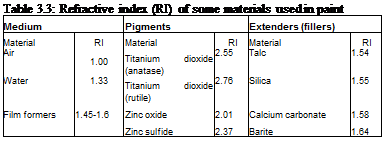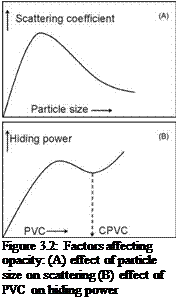Opacity of a pigment is its ability to impart hiding power to the coating film in which it has been incorporated. Pigments render opacity to the coating mainly by two mechanisms:
• Scattering of light
• Absorption of light
Except for black and some saturated deep-blue pigments that absorb most incident light, all other pigments render opacity predominantly by scattering of light, with very little contribution from absorption. White pigments, which do not absorb visible light, achieve opacity
 only by scattering of light. The scattering of light by pigment particles in the medium is a result of a combination of three phenomena — predominantly the refraction of light and to some extent reflection and diffraction of light at the interface between pigment particles and the medium (Figure 3.1).
only by scattering of light. The scattering of light by pigment particles in the medium is a result of a combination of three phenomena — predominantly the refraction of light and to some extent reflection and diffraction of light at the interface between pigment particles and the medium (Figure 3.1).
Figure 3.1: Schematic representation of refraction and diffraction Important factors related to scat-
of light by pigment particles tering power and hence the opa-

city of a pigment are its refractive index and particle size. The larger the difference between the refractive index of pigment particles and that of the medium in which they are dispersed, the higher the opacity. Thus, the high opacity of titanium dioxide and transparency of extenders in a given coating binder can be explained if we take a look at the refractive indices of the materials listed in Table 3.3.
Another important factor affecting the scattering phenomenon is pigment particle size. The ability of pigment particles to scatter light
 increases as the particle size decreases, up to an optimum size (generally about 200 nm). Further decrease in pigment particle size results in decreased scattering (Figure 3.2). The hiding power is proportional to the scattering ability of a pigment; therefore, it follows the same trend and reaches a maximum at an optimum particle size, which is approximately half of the dominant wavelength of light. Ultimate dispersion of these optimum sized pigment particles is equally important to achieve maximum hiding power, because agglomerated particles will behave like a large particle. The refractive index is invariable
increases as the particle size decreases, up to an optimum size (generally about 200 nm). Further decrease in pigment particle size results in decreased scattering (Figure 3.2). The hiding power is proportional to the scattering ability of a pigment; therefore, it follows the same trend and reaches a maximum at an optimum particle size, which is approximately half of the dominant wavelength of light. Ultimate dispersion of these optimum sized pigment particles is equally important to achieve maximum hiding power, because agglomerated particles will behave like a large particle. The refractive index is invariable
for a given compound; therefore, particle size control is an important tool for pigment manufacturers to control opacity. In addition to such physical properties, the amount of pigment in a dry film, commonly expressed as the pigment volume concentration (PVC), is another important factor governing the hiding power of the paint film. PVC is defined as:
% PVC= ________ 100 (Volume of pigment))_____
0 = (Volume of pigment+Volume of medium)
To evaluate the opacity of a pigment, it needs to be dispersed in a suitable vehicle at an appropriate concentration. Subsequently, films of various thicknesses are applied over a black and white substrate (known as a contrast or hiding power chart) and observed for color differences in the black and white portions. The hiding power (expressed in m2/L) can be defined as the reciprocal of the minimum thickness (in mm) of the applied film at which the contrasting substrates cannot be distinguished by visual observation. Instead of applying films at different thicknesses, a coating can also be applied as a wedge-shaped film, and the minimum thickness at which obliteration is observed can be measured.
The visual method has been improved by the use of a photometric method to evaluate the hiding film thickness. In this definition, the hiding power is the reciprocal of the film thickness of a pigmented coating at which the contrast ratio, which is the ratio of the reflectance of a film on a black substrate to that of an identical film on a white substrate, is >0.98. Some photometric methods also use measurement of color difference over black and white portions, while others use measurement of the ratio of YS to YW, which are CIE tristimulus values respectively measured over a black portion and a white portion, as a parameter to evaluate hiding. Further information on evaluation of hiding power of pigmented coatings is found in methods DIN 55987, ASTM D 2805, ISO 6504-1 and ISO 6504-3.
 7 ноября, 2015
7 ноября, 2015  Pokraskin
Pokraskin  Опубликовано в рубрике
Опубликовано в рубрике 